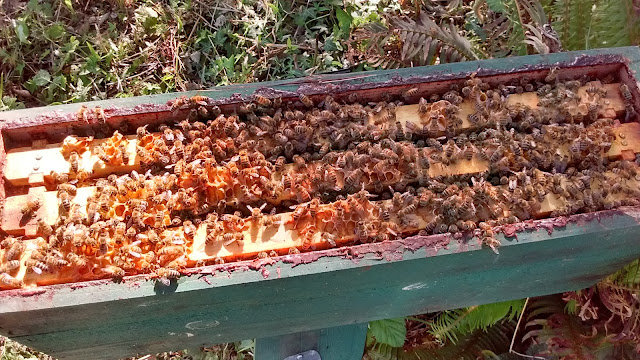Lots of beekeepers when they find decent but unwanted queens cells, instead of cutting them out, pull the frame and set it in a nuc with another frame and food. It's a win-win situation, if it goes well, as one gets a new queen, selected from one one hopes is one't best colony, and likely well fed and cared for. Swarm cells can be pretty big- much larger than what I find when I raise my own queens- and size in queen cells actually matters, so it's a good alternative to grafting, if one only needs a few queens.
I put mine into my 3 frame Western mating boxes, of which I have about 25 I made, before lumber prices shot through the roof. Below is a typical MB in which I placed capped queen cells in with a frame of brood, and lots of bees. Right now I have about 4 of those happening in a few apiaries- I think I'd have more if I was doing such a good (knock on wood) job of swarm prevention this year.

This particular MB has a good size virgin queen, and it was made up about 16 days ago. Another MB at this apiary, set up at the same time, also has a VQ, but a much smaller one. I'll let them both get mated and see how they look then- though likely the smaller queen would be worth weeding out, as one would do in raising grafted queens.
Here's the top of a mating box- which I fill with lots of bees, a frame of brood with the queen cell I want to raise (in the center), a frame of food, and an empty drawn frame. I made these boxes to there is both room at the top for pollen patties if needed, and, more importantly, room at the bottom for a long swarm cell. More than a few times I've lost a swarm cell by setting the frame down where it gets crushed due to a lack of room- sometimes they hang down I think between the frames below them, and have to be set just right.
Here's the empty queen cell, both open at the bottom, and in a state of deconstruction through the sides by the bees:
Here you can just see the virgin queen as she races about- almost dead center in the picture. They can be tough to find, as they aren't their full size yet, but they have a very distinct body shape that catches your eye after some practice.
But typically, you have to find her in a mass like this, and it doesn't always happen. In which case, you just wait a few more weeks and check for eggs, having seen that the cell is hatched, there is lots of food and bees, and no evidence of laying workers. In my experience, I can't really tell by the behavior of the bees- this box for example, was quick to attack (which suggests queenlessness), but has a great queen, the other, with a not-so-good queen, was gentle. I've never really known behavior to be an indicator of anything in a hive, there are too many reasons it can be one way or another, though plenty of smarter people than I suggest one can "read" it.

Once the queens, and the others I have, start laying, and if they look strong, I'll take all three frames, with the queen in the center, and place them directly in hives that need requeening (after removing the queen, and after a few hours at least), without any caging at all. Or- if I want to keep using the MB and its bees, place her in a cage (after marking).
One thing this year I tried, unsuccessfully, and learned from, was trying to do the above early in the season (April), in a full sized brood box (as with a split). Usually this works fine, but early in the year it can be pretty cold at the bottom of a box and if one has a screened bottom board, and not a ton of bees, those queen cells can get cold and die. I had two nice queen cells this year which I did that with, and sure enough, opening them up today, I found them dead, the queen larva colored, but still with encased wings. The smaller mating box I think would help alleviate this, in part as it has so few holes, and can stay warmer.
In a few weeks I'll do a round or two of grafting, but the above is helpful as well in this in-between time when one sometimes needs a spare queen or two.







Comments
Post a Comment